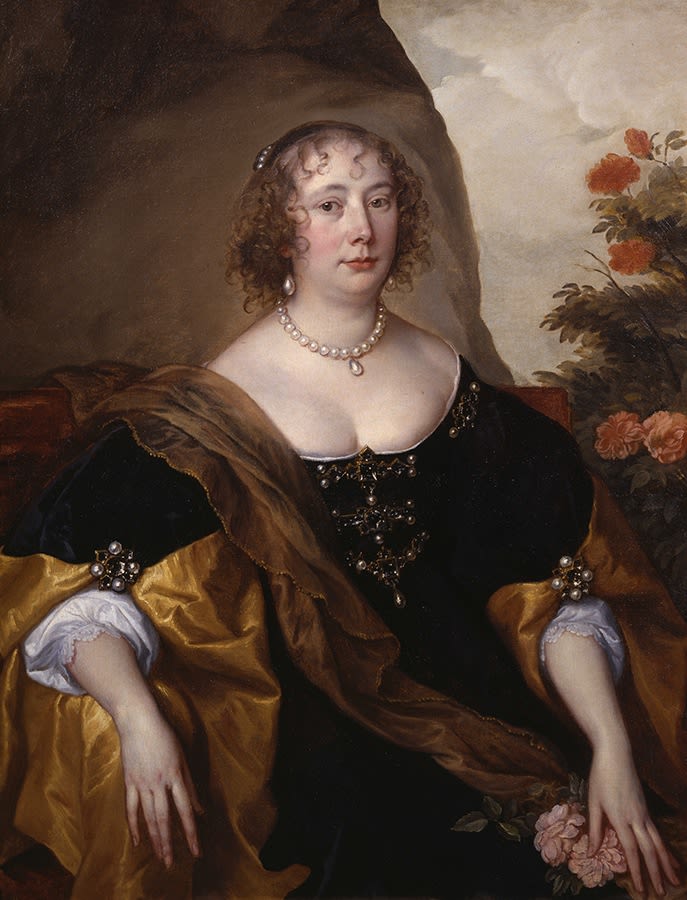
Sir Anthony van Dyck
To view all current artworks for sale visit philipmould.com
The English portraits of Van Dyck display the qualities for which he is renowned, and are a triumphant fulfilment of the excellent potential of his continental works: the sitter combines an aristocratic languor with, through the painstaking and delicate treatment of the face, an immediately discernible personality; the luxurious treatment of costume and jewellery show that the artist has digested fully the lesson learnt from a long study of the opulent Venetian painting of Titian and Veronese, to which he has added his own tricks of colour- the contrast of the black velvet dress with its yellow silk sleeves is characteristic of Van Dyck's bold pigmentation towards the end of his career.
In the instance of this particular painting, a remarkable quality of execution has been revealed since the removal of disfiguring overpaint, in a recent, painstaking restoration. Sir Oliver Millar has remarked this transformation, though he had previously observed that ''the face and jewels are ... freshly handled and there is fine colour in the sleeves.''(1) Since the conservation of this ''very distinguished... portrait'' (2) Sir Oliver noted that the painting appeared ''so much subtler in feeling and colour.'' (3)
Unlike those any later artists who were inspired to emulate Van Dyck, he is remarkable for never repeating a pose in his oeuvre, though there are portraits comparable to this in mood. The rock against which the sitter is placed and the tenebrous sky beyond are Arcadian conceits that were so popular with courtiers during the 1630s. The thornless roses that can be safely grasped that grow by the lady's side, and which she holds in her left hand, are emblematic of purity -a notion reaching back to the imagery of the Virgin Mary as rosa sine spinea - but they also convey a sense of idyllic, private calm as the storm threatens without. The great appeal of Van Dyck for his sitters was that, in addition to its greater technical skill, his portraiture, unlike the more prosaic dignity of images by Cornelius Johnson or Daniel Mytens, enabled Stuart aristocrats to inhabit in paint the world of courtly fantasy that they explored in Masque performances and which may be seen as an escape from the increasingly turbulent politics of the time.
A work such as this entirely justifies Van Dyck's position as the single most influential practitioner of portraiture in Britain, as his work -in the painting of such artists as Reynolds and Gainsborough- not only underlies the painting of the next two centuries but finds a magnificent later expression in the portraits of Sargent.
(1) Private correspondence with Sir Oliver Millar, 27th December 1998.
(2) Private correspondence with Sir Oliver Millar 12th March 1999.
(3) Ibid.
Provenance
Theron J. Blakeslee Collection, New York 1900;Fischoff and Blakeslee Sale, American Art Association, New York 1900 (147 as Sir Peter Lely);
Dowdeswell and Dowdeswell and Blakeslee Sale, American Art Association, New York 1903 (105 as Sir Peter Lely)
McMillin Sale, American Art Association, New York, 20th - 23rd January 1913 (228 as Sir Peter Lely);
Marczell von Nemes Collection, Munich;
Cassirer, Helbig, Munich, 16th - 19th June 1931 (66);
Newhouse Galleries, New York;
Munger Fund Collection, Dallas Museum of Art, 1933 (1933.11.M)
Private Collection USA 1999.
Literature
Gustav Gluck, Van Dyck, Klassiker der Kunst 1931 p. 574Eric Larssen, Van Dyck, The Paintings, 1988, p.365 n.934 ill.
Private Correspondence with Sir Oliver Millar.
Condition and Treatment Report, Simon R. Gillespie Studio, 21st January 1999.
Oliver Millar in Susan J Barnes, Nora de Poorter, Oliver Millar and Horst Vey Van Dyck A Complete Catalogue of the Paintings Yale University Press 2004 p.623